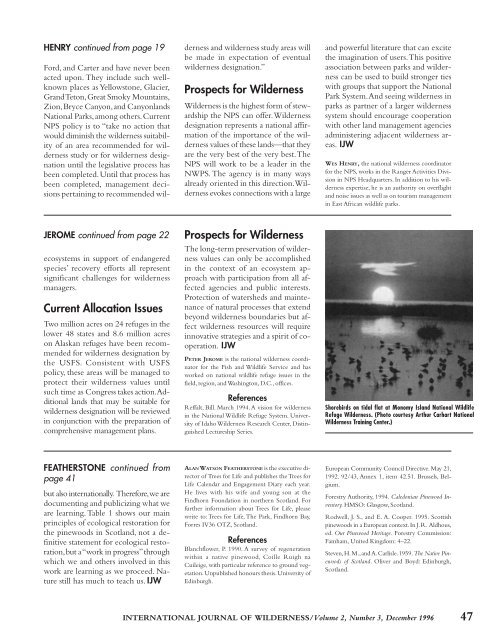P3-Vol 2.No3 Dec 96 - International Journal of Wilderness
P3-Vol 2.No3 Dec 96 - International Journal of Wilderness
P3-Vol 2.No3 Dec 96 - International Journal of Wilderness
Create successful ePaper yourself
Turn your PDF publications into a flip-book with our unique Google optimized e-Paper software.
HENRY continued from page 19<br />
Ford, and Carter and have never been<br />
acted upon. They include such wellknown<br />
places as Yellowstone, Glacier,<br />
Grand Teton, Great Smoky Mountains,<br />
Zion, Bryce Canyon, and Canyonlands<br />
National Parks, among others. Current<br />
NPS policy is to “take no action that<br />
would diminish the wilderness suitability<br />
<strong>of</strong> an area recommended for wilderness<br />
study or for wilderness designation<br />
until the legislative process has<br />
been completed. Until that process has<br />
been completed, management decisions<br />
pertaining to recommended wil-<br />
JEROME continued from page 22<br />
ecosystems in support <strong>of</strong> endangered<br />
species’ recovery efforts all represent<br />
significant challenges for wilderness<br />
managers.<br />
Current Allocation Issues<br />
Two million acres on 24 refuges in the<br />
lower 48 states and 8.6 million acres<br />
on Alaskan refuges have been recommended<br />
for wilderness designation by<br />
the USFS. Consistent with USFS<br />
policy, these areas will be managed to<br />
protect their wilderness values until<br />
such time as Congress takes action. Additional<br />
lands that may be suitable for<br />
wilderness designation will be reviewed<br />
in conjunction with the preparation <strong>of</strong><br />
comprehensive management plans.<br />
FEATHERSTONE continued from<br />
page 41<br />
but also internationally. Therefore, we are<br />
documenting and publicizing what we<br />
are learning. Table 1 shows our main<br />
principles <strong>of</strong> ecological restoration for<br />
the pinewoods in Scotland, not a definitive<br />
statement for ecological restoration,<br />
but a “work in progress” through<br />
which we and others involved in this<br />
work are learning as we proceed. Nature<br />
still has much to teach us. IJW<br />
derness and wilderness study areas will<br />
be made in expectation <strong>of</strong> eventual<br />
wilderness designation.”<br />
Prospects for <strong>Wilderness</strong><br />
<strong>Wilderness</strong> is the highest form <strong>of</strong> stewardship<br />
the NPS can <strong>of</strong>fer. <strong>Wilderness</strong><br />
designation represents a national affirmation<br />
<strong>of</strong> the importance <strong>of</strong> the wilderness<br />
values <strong>of</strong> these lands—that they<br />
are the very best <strong>of</strong> the very best. The<br />
NPS will work to be a leader in the<br />
NWPS. The agency is in many ways<br />
already oriented in this direction. <strong>Wilderness</strong><br />
evokes connections with a large<br />
Prospects for <strong>Wilderness</strong><br />
The long-term preservation <strong>of</strong> wilderness<br />
values can only be accomplished<br />
in the context <strong>of</strong> an ecosystem approach<br />
with participation from all affected<br />
agencies and public interests.<br />
Protection <strong>of</strong> watersheds and maintenance<br />
<strong>of</strong> natural processes that extend<br />
beyond wilderness boundaries but affect<br />
wilderness resources will require<br />
innovative strategies and a spirit <strong>of</strong> cooperation.<br />
IJW<br />
PETER JEROME is the national wilderness coordinator<br />
for the Fish and Wildlife Service and has<br />
worked on national wildlife refuge issues in the<br />
field, region, and Washington, D.C., <strong>of</strong>fices.<br />
References<br />
Reffalt, Bill. March 1994. A vision for wilderness<br />
in the National Wildlife Refuge System. University<br />
<strong>of</strong> Idaho <strong>Wilderness</strong> Research Center, Distinguished<br />
Lectureship Series.<br />
ALAN W ATSON FEATHERSTONE is the executive director<br />
<strong>of</strong> Trees for Life and publishes the Trees for<br />
Life Calendar and Engagement Diary each year.<br />
He lives with his wife and young son at the<br />
Findhorn Foundation in northern Scotland. For<br />
further information about Trees for Life, please<br />
write to: Trees for Life, The Park, Findhorn Bay,<br />
Forres IV36 OTZ, Scotland.<br />
References<br />
Blanchflower, P. 1990. A survey <strong>of</strong> regeneration<br />
within a native pinewood, Coille Ruigh na<br />
Cuileige, with particular reference to ground vegetation.<br />
Unpublished honours thesis. University <strong>of</strong><br />
Edinburgh.<br />
and powerful literature that can excite<br />
the imagination <strong>of</strong> users. This positive<br />
association between parks and wilderness<br />
can be used to build stronger ties<br />
with groups that support the National<br />
Park System. And seeing wilderness in<br />
parks as partner <strong>of</strong> a larger wilderness<br />
system should encourage cooperation<br />
with other land management agencies<br />
administering adjacent wilderness areas.<br />
IJW<br />
WES HENRY, the national wilderness coordinator<br />
for the NPS, works in the Ranger Activities Division<br />
in NPS Headquarters. In addition to his wilderness<br />
expertise, he is an authority on overflight<br />
and noise issues as well as on tourism management<br />
in East African wildlife parks.<br />
Shorebirds on tidal flat at Monomy Island National Wildlife<br />
Refuge <strong>Wilderness</strong>. (Photo courtesy Arthur Carhart National<br />
<strong>Wilderness</strong> Training Center.)<br />
European Community Council Directive. May 21,<br />
1992. 92/43, Annex 1, item 42.51. Brussels, Belgium.<br />
Forestry Authority, 1994. Caledonian Pinewood Inventory.<br />
HMSO: Glasgow, Scotland.<br />
Rodwell, J. S., and E. A. Cooper. 1995. Scottish<br />
pinewoods in a European context. In J. R. Aldhous,<br />
ed. Our Pinewood Heritage. Forestry Commission:<br />
Famham, United Kingdom: 4–22.<br />
Steven, H. M., and A. Carlisle. 1959. The Native Pinewoods<br />
<strong>of</strong> Scotland. Oliver and Boyd: Edinburgh,<br />
Scotland.<br />
INTERNATIONAL JOURNAL OF WILDERNESS/<strong>Vol</strong>ume 2, Number 3, <strong>Dec</strong>ember 19<strong>96</strong> 47










